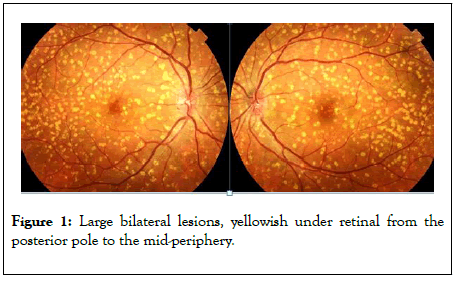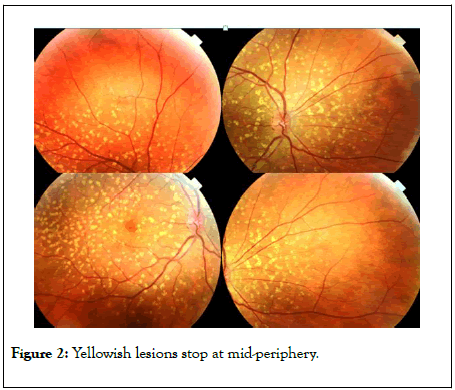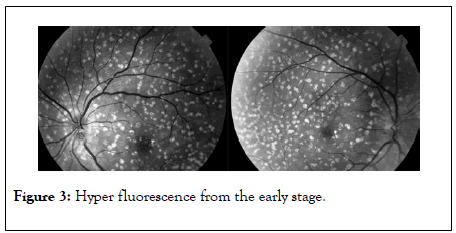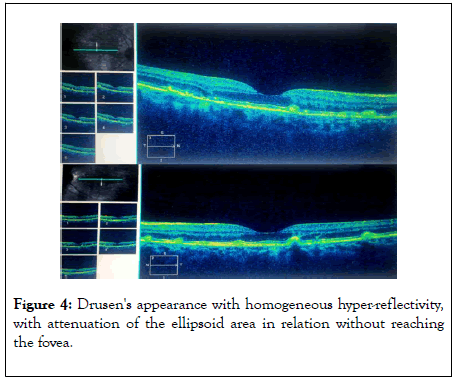Indexed In
- RefSeek
- Hamdard University
- EBSCO A-Z
- Geneva Foundation for Medical Education and Research
- Euro Pub
- Google Scholar
Useful Links
Share This Page
Journal Flyer
Open Access Journals
- Agri and Aquaculture
- Biochemistry
- Bioinformatics & Systems Biology
- Business & Management
- Chemistry
- Clinical Sciences
- Engineering
- Food & Nutrition
- General Science
- Genetics & Molecular Biology
- Immunology & Microbiology
- Medical Sciences
- Neuroscience & Psychology
- Nursing & Health Care
- Pharmaceutical Sciences
Short Communication - (2020) Volume 5, Issue 3
Large Colloid Drusen in Young Patient
Mehdi Khamaily*, Imane Tarib, Yassine Mouzari, Joumany Brahim Salem, Taoufik Abdellaoui, Fouad El Asri, Karim Reda and Abdelbarre OubaazReceived: 02-Jul-2020 Published: 22-Jul-2020, DOI: 10.35248/2684-1622.20.5.138
Abstract
Drusen are yellow or white accumulations of extracellular material made up of lipids and proteins, that build up
between basal blade of retinal pigment epithelium and collagen layer of Bruch’s membrane.
They are the most common clinical manifestation of aging and usually occur in the population over 50 years old,
however a special entity may occur earlier, especially Large Colloid Drusen.
Large Colloid Drusen most often develops in women with no family history of retinopathy, with a low risk of
choroidal neovascularization or significant loss of visual acuity.
We report the case of a 45 years old female patient, with no prior ophthalmological or general history, who presented
to the consultation for decreased near visual acuity.
Keywords
Drusen; Young; Colloid
Study Description
The far visual acuity was 20/20 OU without correction, examination of the anterior segment was normal [1-5].
At the Fundoscopy, Large bilateral lesions, yellowish under retinal from the posterior pole to the mid-periphery, (Figure 1) without reaching the extreme retinal periphery Figure 2.

Figure 1: Large bilateral lesions, yellowish under retinal from the posterior pole to the mid-periphery.

Figure 2: Yellowish lesions stop at mid-periphery.
Fluorescein angiography objected, hyperfluocescence in early and late times Figure 3.

Figure 3: Hyper fluorescence from the early stage.
Macular OCT, Convex shaped drusen with homogeneous internal hyper-reflectivity, and attenuation of the ellipsoid zone in relation without reaching the fovea Figure 4.

Figure 4: Drusen's appearance with homogeneous hyper-reflectivity, with attenuation of the ellipsoid area in relation without reaching the fovea.
REFERENCES
- Guigui B, Querques G, Leveziel N, Bouakkaz H, Massamba N, Coscas G, et al. Spectral domain optical coherence tomography of early onset large colloid drusen. Retina. 2013;33(7):1346-1350.
- De Bats F, Wolff B, Mauget-Faÿsse M, Meunier I, Denis P, Kodjikian L. Association of reticular pseudodrusen and early onset drusen. ISRN Ophthalmol. 2013;273085.
- Nathália Corbelli roberti, João rafael de oliveira dias, Eduardo amorim Novais, Caio saito regatieri, rubeNs belfort Jr. Large colloid drusen analyzed with structural en face optical coherence tomography. Arq Bras Oftalmol. 2017;80(2):122-124.
- Sinem Nihal Esatogln. Update on the treatment of Behcet’s syndrom. Intern Emerg Med. 2019;14:661-675.
- Jing Zhangetal. A review of behcet’s disease from perspectives of both western and chinese medicine. J Tradit Chi Med. 2019;39(1):139-152.
Citation: Khamayli M, Tarib I, Mouzari Y, Salem JB, Abdellaoui T, Asri FE, et al. (2020) Treatment of the Refractory Glaucoma by the Micropulse Transcleral Diode Laser Cyclophotocoagulation. J Eye Dis Disord 5: 138. DOI: 10.35248/2684-1622.20.5.138
Copyright: © 2020 Khamayli M, et al. This is an open-access article distributed under the terms of the Creative Commons Attribution License, which permits unrestricted use, distribution, and reproduction in any medium, provided the original author and source are credited.
